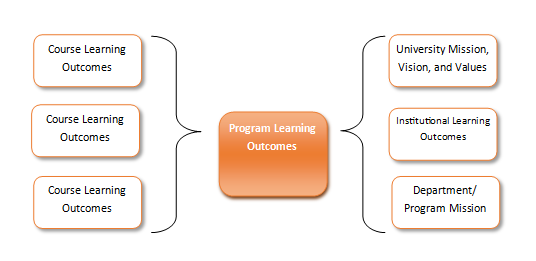Why Learning Outcomes?
In a January 09, 2018 blogpost, Assessment author and consultant Dr. Linda Suskie discusses the value of articulating learning outcomes:
Clearly defined learning outcomes can:
- Help students navigate important milestones by making implicit program expectations explicit, especially to first-generation students who may not know the “rules of the game.”
- Help prospective students weigh the costs and benefits of their educational investments.
- Help faculty prepare students more purposefully for a variety of career paths (at the doctoral level, for teaching as well as research careers).
- Help faculty ensure that students graduate with the knowledge and skills they need for an increasingly broad range of career options, which at the doctoral level may include government, non-profits, and startups as well as higher education and industry.
- Help faculty make program requirements and milestones more student-centered and intentional.
- Help faculty, programs, and institutions define the value of a degree or other credential and improve public understanding of that value.
- Put faculty, programs, and institutions in the driver’s seat, defining the characteristics of a successful graduate rather than having a definition imposed by another entity such as an accreditor or state agency.
Learning Outcomes Statements
The design of curriculum including instruction, educational experiences, and assessment, describe what student should be able to know and do in relation to what they have learned. Collectively, Course Learning Outcomes (CLOS) are represented in Program Learning Outcomes (PLOs). PLOs are also informed by the University Mission, Strategic Plan, Institutional Learning Outcomes (Baccalaureate and Graduate), the General Education Learning Outcomes, and Department/Program Mission Statements as illustrated below:

Program Learning Outcomes
Each program defines itself and its uniqueness through Program Learning Outcomes (PLOs). Defining the types of learning students will collectively be able to demonstrate or produce from courses in the programs are PLOs.
Program Learning Outcomes are reviewed each year as part of the catalog review process. Any changes to PLOs should be indicated in the annual assessment report.
- Program Learning Outcomes - All program learning outcomes are published on the University Academics page.
Course Learning Outcomes
Course Learning Outcomes (CLOs) are statements that specify what students will know or be able to do as a result of their experience in the course. The statements begin with a stem such as "Students will be able to <<insert verb and describe what they will know or be able to do>>. " CLOs are expressed as knowledge, skills, attitudes, and/or dispositions. Well-written CLOs have the characteristics of describing student actions that must be:
- Observable
- Measurable (consistently by different observers/scorers)
- Demonstrated
Bloom's Taxonomy provides levels and verbs used for stating specific behavioral learning outcomes. It is important to avoid verbs that are unclear and subject to different interpretations such as: know, become aware of, be familiar with, appreciate, learn, and understand.
Revised Bloom's Taxonomy Action Verbs
A comparison of unclear learning outcomes and examples of clear learning outcomes follows:
| Unclear Learning Outcomes | Clear Learning Outcomes |
|---|---|
| Students understand the nine reasons for conducting a needs assessment. | Replace understand. Students will be able to list/describe/illustrate the nine reasons for conducting a needs assessment. |
| Students develop an appreciation of cultural diversity in the workplace. | Replace develop an appreciation. Students will describe how different cultures in their workplace contribute to a learning community. |
For a tutorial on Writing Learning Outcomes see:
For more information on Writing Learning Outcomes see:
Updated: October 11, 2024